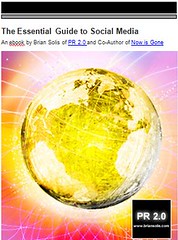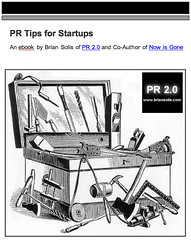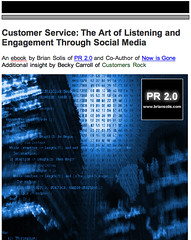Extra Extra, Read All About It! Newspapers Respond to the Social Web

Source
Yes, the headline isn't really breaking news to many of us. However, I received an interesting report this week that ties numbers to the tumultuous newspaper industry and its struggle to remain relevant, today and tomorrow. I wanted to share the numbers with you...
Every year, The Bivings Group, analyzes how and to what extent America's largest newspapers are embracing the Web. With Social Media opening the flood gates for innovation in online content creation and distribution, newspapers are struggling to swim back upstream - even though the proverbial "upstream" no longer exists. Attaining previous stature is impossible without a self-inflicted renaissance. Something new and evolutionary is well overdue in order to sustain a loyal readership, reconnect with those who may have moved elsewhere, and also attract a new generation of readers.
Through social networks, blogs, and micro communities, consumers have access to information literally as it happens. Twitter, Facebook, FriendFeed, and other networks ARE emerging as trusted and oft referenced newsfeeds. And, they're fueled by immediacy, brevity, and connectedness. Our diet for knowledge is now actively fed through portioned micro bytes, by the community, for the community. We are plugged into "the wire."
Circulation is dramatically dropping. Layoffs are widespread. And, it's all tied to the vanishing sources of revenue as Madison Ave. tries to play catch-up to the increasingly elusive "eyeballs" they wish to allure.
According to a recent article in Reuters, Print ad revenue is down 19.26 percent to $8.2 billion (Down 16.07 percent in Q2, down 14.38 percent in Q1). Online ad revenue down 3 percent to $749.8 million (Down 2.4 percent in Q2, up 7.2 percent in Q1). Combined is down 18.11 percent to $8.94 billion (Down 15.11 percent in Q2, Down 12.85 percent in Q1).
Newspapers are are experimenting with social tools to source and share information and also to create and cultivate an active community that connects the media property to various micro communities. Unfortunately, for many, experimentation through socialization doesn't necessarily provide a newspaper bailout (#newspaperbailout) plan. Like in anything related to the Social Web, an outbound, community-focused champion or team of evangelists, in addition to a more social platform, is required to simply compete.
The Bivings Group examined the websites of the top 100 newspapers in the United States, as determined by circulation (via the Audit Bureau of Circulations). The research gauges how newspapers are responding to the threat and opportunity presented by the rise of online communities and networks as sources of news.
Key findings include:
Newspapers are experimenting with user generated content. The study found that 58 percent of newspapers allowed for user generated photos, while 18 percent accepted video and 15 percent articles. Overall, 58 percent of newspapers offered some form of user generated content in 2008 compared to 24 percent in 2007.
Research shows that the number of newspaper websites allowing users to comment on articles has more than doubled in the last year. Seventy five percent of newspapers now accept article comments in some form, compared to 33 percent in 2007.
Ten percent of newspapers had social networking tools, such as user profiles and the ability to “friend” other users, built into their sites in 2008. This compares to five percent of sites that included this feature in 2007. It is surprising that this number isn’t higher.
Seventy six percent of newspapers offered a Most Popular view of content in some form (Most Emailed, Most Blogged, Most Commented, etc.). This compares to 51 percent in 2007 and 33 percent in 2006.
Integration with external social bookmarking sites like Digg and del.icio.us has increased dramatically the last few years. Ninety-two percent of newspapers now include this option compared to only seven percent in 2006.
Every newspaper the study examined featured some sort of online advertising. Indeed, 100% of newspapers provided some form of contextual advertising, such as Google Adwords. Forty-three percent of newspaper websites used interstitial advertising.
Of the new features examined in this year’s study, we found that 57 percent of newspapers offer PDF editions, 20 percent offer chatting options, 96 percent provide local weather information, 40 percent utilize SMS alerts and 70 percent offer community event calendars.
The number of websites requiring registration to view most content (free or paid) has decreased from 2007. Now only 11 percent of websites require registration to view full articles, compared to 29 percent in 2007 and 23 in 2006.
All of the 100 newspapers in the study provide some type of RSS feed. In 2007 all but three newspapers offered RSS feeds.
The full study is available for download here.
---
Connect with me on:
Twitter, FriendFeed, LinkedIn, Tumblr, Plaxo, Plurk, Identi.ca, BackType, Jaiku, Social Median, or Facebook
---
Subscribe to the PR 2.0 RSS feed.
---
newspaper news pr2.0 pr 2.0 PR+2.0 social+media social media brian+solis public+relations media+2.0 media2.0 web social+web community micro twitter facebook friendfeed












3 Comments:
My local newspaper, marinij.com, twitter.com/marinij, is active in social media. I've helped them break two stories via Twitter communication, and they've provided by-the-minute breaking stories about three different events in my town, one as I was driving by, wondering why the cops had shut down a street. Good job, MarinIJ!
unfortunately, most online sources (newspapers) paid no attention to how users interact with information when designing their portals. Those that offer used centered design and genuinely reach out to users might stand a chance. Unfortunately most old school publishers are not very forward thinking and this is all very much too little, too late.
Someone or something will come out in top... but it won't be done by copying their competition.
Mary Wallace just gave newspapers another helpful hint which will give them wider access to the things social media can contribute.
Hats off to the newspapers! Cheers to community-driven web.
Best.
Alain Yap
Morph Labs
Post a Comment
<< Home